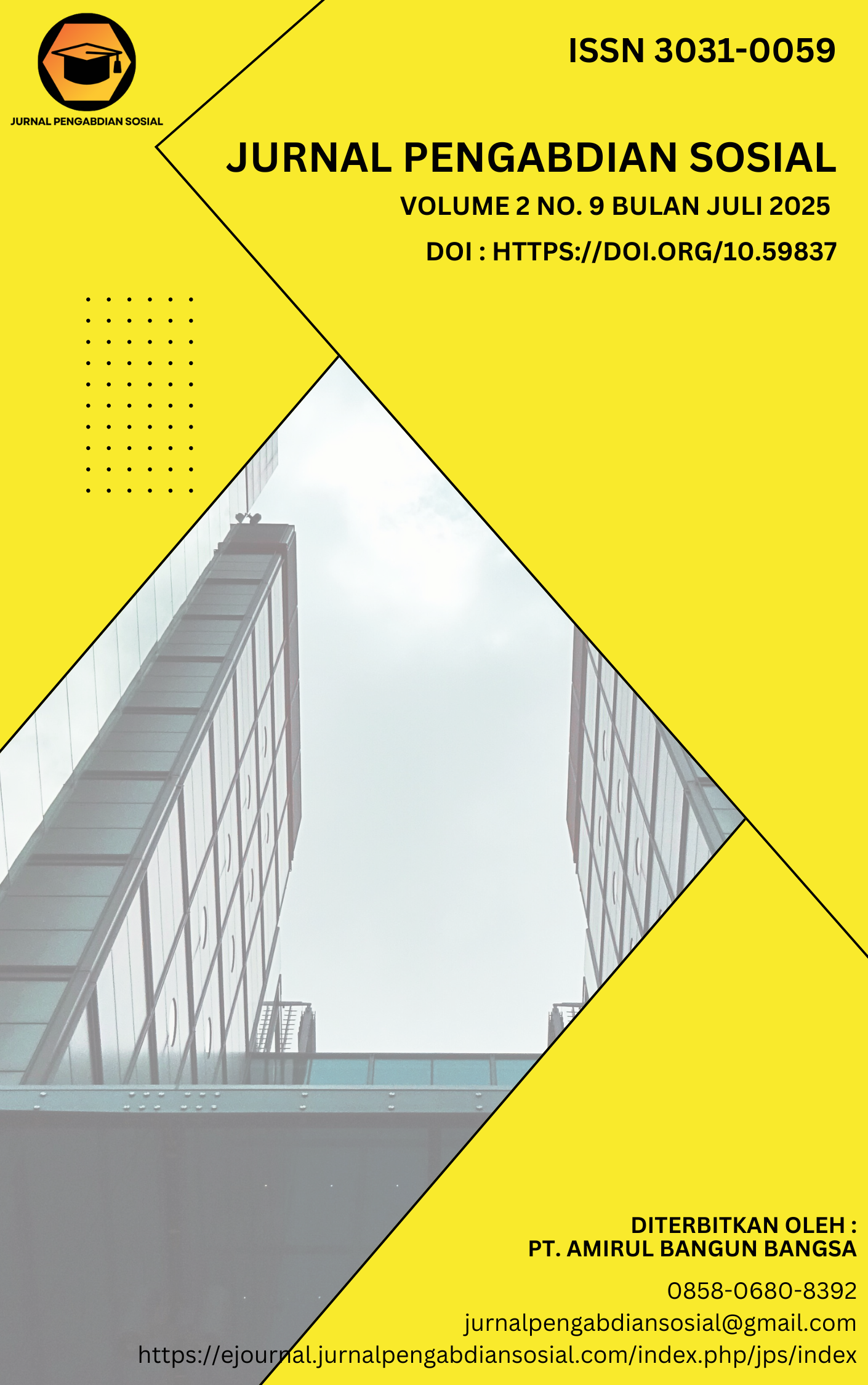Peran Edukasi Status Gizi dan Evaluasi Lemak Subkutan melalui Skinfold Caliper sebagai Upaya Pencegahan Obesitas di Cengkareng
DOI:
https://doi.org/10.59837/papx2907Keywords:
Skinfold Caliper, Lemak Tubuh, Status Gizi, Obesitas, Edukasi MasyarakatAbstract
Distribusi lemak subkutan memiliki nilai diagnostik penting dalam penilaian status gizi dan risiko metabolik. Kegiatan ini bertujuan untuk mengevaluasi ketebalan lemak subkutan dan memberikan edukasi kesehatan sebagai upaya pencegahan obesitas pada populasi usia produktif. Metode kegiatan dilakukan melalui pemeriksaan ketebalan lipatan kulit menggunakan skinfold caliper pada 57 peserta dewasa di Sekolah Yayasan Baptis Cengkareng, dengan titik pengukuran di biseps, triseps, suprailiaka, dan subscapula. Hasil pemeriksaan menunjukkan bahwa ketebalan lemak subkutan tertinggi terdapat pada suprailiaka (17,88 mm) dan subscapula (14,94 mm), sedangkan biseps dan triseps memiliki nilai lebih rendah. Mayoritas peserta memiliki kategori lemak rendah pada area lengan, sementara distribusi lemak di area batang tubuh lebih bervariasi. Hasil kegiatan ini digunakan sebagai dasar edukasi kelompok mengenai hubungan distribusi lemak tubuh, pola konsumsi makanan, dan risiko obesitas, sehingga pemeriksaan skinfold caliper terbukti efektif sebagai alat skrining komunitas dan sarana edukasi kontekstual dalam meningkatkan kesadaran masyarakat tentang pentingnya pengendalian berat badan.
References
Anyene, I., Caan, B., Williams, G. R., Popuri, K., Lenchik, L., Giri, S., Chow, V., Beg, M. F., & Cespedes Feliciano, E. M. (2022). Body composition from single versus multi-slice abdominal computed tomography: Concordance and associations with colorectal cancer survival. Journal of Cachexia, Sarcopenia and Muscle, 13(6), 2974–2984. https://doi.org/10.1002/jcsm.13080
Baltadjiev, A. G., Vladeva, S. V, & Bahariev, D. B. (2018). Anthropological Characteristic of the Distribution of Adipose Tissue in Bulgarian Females with Type 2 Diabetes Mellitus. Folia Medica, 60(3), 411–416. https://doi.org/10.2478/folmed-2018-0005
Gedtal, M., Woodside, J., Wright, D., Rayman, M., & Hogg, R. E. (2024). Subscapular skinfold thickness, not other anthropometric and dual-energy X-ray absorptiometry-measured adiposity, is positively associated with the presence of age-related macular degeneration: a cross-sectional study from National Health and Nutrition Examination Survey 2005-2006. BMJ Open Ophthalmology, 9(1). https://doi.org/10.1136/bmjophth-2023-001505
Gomes, A. C., Landers, G. J., Binnie, M. J., Goods, P. S. R., Fulton, S. K., & Ackland, T. R. (2020). Body composition assessment in athletes: Comparison of a novel ultrasound technique to traditional skinfold measures and criterion DXA measure. Journal of Science and Medicine in Sport, 23(11), 1006–1010. https://doi.org/10.1016/j.jsams.2020.03.014
Guzmán-de la Garza, F. J., González Ayala, A. E., Gómez Nava, M., Martínez Monsiváis, L. I., Salinas Martínez, A. M., Ramírez López, E., Mathiew Quirós, A., & Garcia Quintanilla, F. (2017). Body frame size in school children is related to the amount of adipose tissue in different depots but not to adipose distribution. American Journal of Human Biology : The Official Journal of the Human Biology Council, 29(5). https://doi.org/10.1002/ajhb.23014
Koçak, F. A., Kurt, E. E., Milletli Sezgin, F., Şaş, S., Tuncay, F., & Erdem, H. R. (2020). The effect of balneotherapy on body mass index, adipokine levels, sleep disturbances, and quality of life of women with morbid obesity. International Journal of Biometeorology, 64(9), 1463–1472. https://doi.org/10.1007/s00484-020-01924-x
Kristiansen, H., Eide, G. E., Brannsether, B., Roelants, M., Bjerknes, R., & Júlíusson, P. B. (2018). Associations between different weight-related anthropometric traits and lifestyle factors in Norwegian children and adolescents: A case for measuring skinfolds. American Journal of Human Biology : The Official Journal of the Human Biology Council, 30(6), e23187. https://doi.org/10.1002/ajhb.23187
Laforest, S., Michaud, A., Paris, G., Pelletier, M., Vidal, H., Géloën, A., & Tchernof, A. (2017). Comparative analysis of three human adipocyte size measurement methods and their relevance for cardiometabolic risk. Obesity (Silver Spring, Md.), 25(1), 122–131. https://doi.org/10.1002/oby.21697
Liu, Y., Li, Y., He, J., Ma, P., Yu, L., Zheng, Q., & Sun, G. (2018). Gender Stratified Analyses of the Association of Skinfold Thickness with Hypertension: A Cross-Sectional Study in General Northeastern Chinese Residents. International Journal of Environmental Research and Public Health, 15(12). https://doi.org/10.3390/ijerph15122748
Ong, J. N., Ducker, K. J., Furzer, B. J., Dymock, M., & Landers, G. J. (2023). Acute exercise affects dual-energy X-ray absorptiometry body composition estimates but not standardised ultrasound measurements of subcutaneous adipose tissue. Clinical Physiology and Functional Imaging, 43(5), 345–353. https://doi.org/10.1111/cpf.12832
Oyhenart, E. E., Castro, L. E., Garraza, M., Cesani, M. F., Torres, M. F., Quintero, F. A., Dahinten, S. L., Alfaro, E. L., Bejarano, I. F., Carrillo, R. Á., Dip, N. B., Lomaglio, D., Marrodán, M. D., Menecier, N., Navazo, B., Román, E. M., Zonta, M. L., & Dipierri, J. E. (2019). Comparative study of mid-upper arm circumference, arm muscle area and arm fat area percentiles in Argentinean and US children aged 4-14 years. Nutricion Hospitalaria, 36(3), 552–562. https://doi.org/10.20960/nh.02426
Ruslim, D., Destra, E., Gunaidi, F. C., & Fadhila, A. I. (2024). Deteksi Dini Obesitas melalui Pemeriskaan Komposisi Tubuh pada Populasi Usia Produktif di SMAN 75, Jakarta Utara. SAFARI :Jurnal Pengabdian Masyarakat Indonesia, 4(3), 263–268. https://doi.org/10.56910/safari.v4i3.1664
Santoso, A. H., Setiawan, F. V., Wijaya, B. A., & Destra, E. (2024). Pengukuran Komposisi Tubuh dalam Upaya Deteksi Obesitas pada Laki-laki dan Perempuan Usia Produktif di SMA Kalam Kudus II, Kelurahan Duri Kosambi, Jakarta. KREATIF: Jurnal Pengabdian Masyarakat Nusantara, 4(2), 78–86.
Sari, T., Gracienne, G., Hariesti, R. A., Destra, E., Gunaidi, F. C., & Firmansyah, Y. (2024). Edukasi dan Skrining Pentingnya Pemantauan Obesitas Terhadap Terjadinya Resistensi Insulin Pada Lanjut Usia. Jurnal Pengabdian Bidang Kesehatan, 2(2), 64–72.
Shrivastava, U., Fatma, M., Mohan, S., Singh, P., & Misra, A. (2017). Randomized Control Trial for Reduction of Body Weight, Body Fat Patterning, and Cardiometabolic Risk Factors in Overweight Worksite Employees in Delhi, India. Journal of Diabetes Research, 2017, 7254174. https://doi.org/10.1155/2017/7254174
Sullivan, K., Metoyer, C. J., Winchester, L. J., Esco, M. R., & Fedewa, M. V. (2023). Agreement between ultrasound protocols for the estimation of body fat percentage: Comparison to a four-compartment model. Clinical Physiology and Functional Imaging, 43(5), 373–381. https://doi.org/10.1111/cpf.12835
Tafeit, E., Kaimbacher, P. S., Wallner-Liebmann, S. J., Reibnegger, G., Cvirn, G., Jürimäe, J., Saar, M., Maestu, J., Purge, P., Lätt, E., & Jürimäe, T. (2015). Caliper vs. Lipometer--Comparing Two Methods of Subcutaneous Body Fat Measurement by Bland-Altman Diagrams. Collegium Antropologicum, 39(3), 611–615.
Tinggaard, J., Hagen, C. P., Christensen, A. N., Mouritsen, A., Mieritz, M. G., Wohlfahrt-Veje, C., Helge, J. W., Beck, T. N., Fallentin, E., Larsen, R., Jensen, R. B., Juul, A., & Main, K. M. (2017). Anthropometry, DXA, and leptin reflect subcutaneous but not visceral abdominal adipose tissue on MRI in 197 healthy adolescents. Pediatric Research, 82(4), 620–628. https://doi.org/10.1038/pr.2017.138
Wang, J., He, L., Yang, N., Li, Z., Xu, L., Li, W., Ping, F., Zhang, H., & Li, Y. (2022). Large mid-upper arm circumference is associated with reduced insulin resistance independent of BMI and waist circumference: A cross-sectional study in the Chinese population. Frontiers in Endocrinology, 13, 1054671. https://doi.org/10.3389/FENDO.2022.1054671/BIBTEX
Downloads
Published
Issue
Section
License
Copyright (c) 2025 Andria Priyana, Alexander Halim Santoso, Edwin Destra, Daniel Goh, Gracienne Gracienne (Author)

This work is licensed under a Creative Commons Attribution 4.0 International License.













